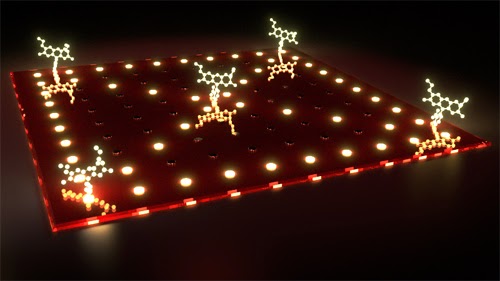Researchers at Aalto University have experimentally demonstrated strong coupling between emitters and surface plasmon polariton (SPP) modes that are of a collective nature, implying that in the presented structures, distant emitters are coherently coupled at room temperature. The results are published in the journal Nano Letters.
The key factor here is the role of the SPPs: SPPs consist of light and electron oscillations in metal; they enable the confinement of light into the nanoscale, well below the free space wavelength of light.
In the work of the Aalto researchers, the SPPs on individual silver nanoparticles are combined by arranging the particles in a regular array. The individual SPPs couple in a coherent manner, which creates collective SPP modes. These exotic light modes are then shown to couple strongly with organic dye molecules, leading to hybrids of collective, single nanoparticle and molecular modes. The strong-coupling regime of light-matter interaction is the basis for various important coherence phenomena such as Rabi oscillations, threshold-less lasing and ultrafast energy transfer.
The findings of the Aalto researchers open up totally new prospects in nanoplasmonics: the combination of low losses (long life-times) and the non-local nature of the collective modes has the potential to provide interesting phenomena on the nanoscale, especially if one can place single quantum emitters on the nanoparticles. This collective-mode plasmonic strong-coupling regime has the potential for the creation of light emission where collective effects are utilized.
The silver nanoparticle arrays were fabricated by electron-beam lithography in the Micronova clean room, and the arrays were combined with organic dye-molecules (Rhodamine 6G).
For the article in Nano Letters, please visit http://pubs.acs.org/doi/abs/10.1021/nl4035219. An artist’s view of the results will appear as the cover picture of the Nano Letters April 2014 issue.
Source: http://sci.aalto.fi/en/current/news/view/2014-01-16/


No comments:
Post a Comment